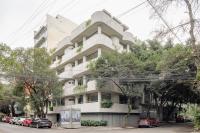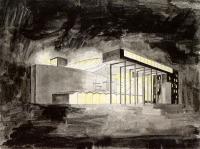Estádio Nacional
Brasilia, Brazil
The Brazilian capital that is listed as world heritage by UNESCO has just turned 50 years old. Brasilia is almost a “sacred city” of the modern age for structural engineers and architects. The architects of gmp and the engineers of schlaich bergermann und partner, together with Castro Mello architects and Luis Pitta ETALP engineers were therefore honored to be part of the team adding another monumental building to Niemeyer’s and Costa’s ensemble. This way a new multifunctional stadium was created that draws on the tradition of Brasilia. The interplay between ramps, bridges, long slender pillars, and the monumental circular roof projecting far over the stadium bowl comprise the key characteristics of the design. The combination of the lightweight membrane roof floating within a sturdy concrete structure created a remarkable building that lives up to its location. Since 2010 the National Stadium in Brasilia had been modernized to meet the FIFA requirements for the 2014 World Cup. On 18th May 2013 it was ready for the first match under the new roof. During the FIFA World Cup several group stage matches, and one semi- final match within the second stage will take place in the national stadium in Brasilia.
The reinforced concrete structure of the stadium roof comprises the Esplanade, the circle of columns that consists of 288 concrete pillars, as well as the concrete compression ring of the cable-net roof. The entire structure is based on a perfect circle based on 96 radial and 3 tangential ring axes of the concrete pillars. The 288 concrete pillars are up to 61m tall and with a diameter of 1.2 to 1.5m extremely slender. The 22 m wide tapered concrete compression ring has an outer diameter of 309m. The great tensile forces of the cable structure are anchored in the radial walls by means of strand- bundle cables.The suspended roof consists of a cable-net that features 48 radial cables. These connect the compression ring to the tension ring. On top of this are the slender radial and tangential truss girders which are continuously stabilized by the pin-jointed membrane arches.,The entire roof is wrapped into a PTFE fiberglass membrane.
Building information
Start of design phase: December 2008
Completion: March 2013
Capacity: 72 800 spectators
Covered floor area: 67 000m2
Dimensions: ∅ 309m (outer edge of compression ring), ∅ 102m (roof opening)
Steel structure: approx. 2,200 tons
Surface of compression ring: 20,000m2
Membrane surface: 40,000m2 fiberglass - PTFE
Poly-carbonate surface: 70,000m2
Total roof surface: 47,000m2
Depth of roof: 81.5m (suspended roof with cantilever), + 22m compression ring = 103.5 m
Parties involved
Client: Novacap, Brasilia
Design roof/Esplanade: gmp Architekten von Gerkan, Marg und partner; schlaich bergermann und partner; Castro Mello Arquitetos
Architects: gmp Architekten von Gerkan, Marg und Partner Castro Mello Arquitetos, São Paulo
Structural design: Design, structural engineering and site schlaich bergermann und partner, Knut Göppert with Knut Stockhusen and Miriam Sayeg
Stadium bowl: Etalp, São Paulo
Prime contractor: JV Andrade Guitierrez / VIA
Wind tunnel testing: Wacker Ingenieure











